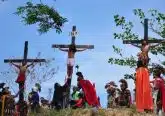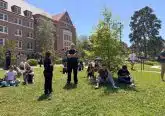Study abroad: Bringing home additional tools for child protection
By Carol Glatz
VATICAN CITY (CNS) — When Drew Dillingham packs his bags after spending the past five months in Rome, he will head back to Washington, D.C., with a unique diploma and added insight into ways the church can continually improve on its duty to protect children from abuse.
While the intensive semester-long course was taught by experts in the fields of psychology, canon law, and theology, much of the learning also came from having 24 classmates — priests, religious and lay men and women working in the field of safeguarding minors — who came from 18 different countries, Dillingham told Catholic News Service June 7.
So, for example, he said, many students from developing countries are also dealing with the crimes and scandal of children being forced into war, slave labor, marriage and prostitution. “So child sexual abuse by clergy is just one of the many issues that they’re combating,” he said.
Their efforts and experiences, he said, made him wonder “how else can the church expand its ministry” so that everything the church has learned from the clergy sexual abuse crisis can be used “to provide pastoral care to these other victims of other heinous crimes and sins.”
Dillingham is the coordinator for resources and special projects at the U.S. Conference of Catholic Bishops’ Child and Youth Protection Office, helping dioceses work to keep children safe from abuse and provide needed assistance to victims.
Aiming to ensure the safeguarding of minors will remain a top priority for generations to come and to help train future leaders, the bishops’ conference sent Dillingham to Rome for intensive studies at the Pontifical Gregorian University’s specialized degree program in protecting minors.
Created in 2016 to help dioceses, bishops’ conferences, religious orders and other church bodies improve child protection efforts, it’s the only interdisciplinary diploma program of its kind. The program is geared particularly toward staff from developing nations, Dillingham said, helping them create and implement protection guidelines, and help them as they realize “what an important part of church ministry this really is.”
In the 15 years since the USCCB drafted its Charter for the Protection of Children and Young People and created the protection office, he said, they are still seeking new ways to improve based on what they’ve learned since 2002.
The biggest thing many dioceses need, he said, is to ask, “What can we do better? How can we provide better assistance and support to victims? How can we look at our past problems, especially those that have emerged recently in some dioceses and learn from them? How can we really get to the root cause of the abuse scandals and eliminate those causes?”
Another need, he said, is to continue changing the culture that helped deny and hide abuse and protected an institution over the people who needed help the most.
“Even before 2002, we had policies and procedures in place, but we didn’t have the culture that said the safety of children is very important, the support of victims is part of our core ministry,” he said.
He said the bishops’ conferences are trying to build that culture not only at the top leadership level, but also at the local parish level since child protection “is also the role of the entire church community.”
Dillingham recalled that when the extent of abuse by clergy in the United States gained nationwide attention in 2001, he was just 11 years old.
At the time in his parish in his native Long Island, New York, “there was still silence on this issue so as a young person, I had no idea that any of this was happening. There was still this general sense that this was something made up by the media,” he said.
He said he thinks it has only been recently that some “people in the church have truly understood the weight of the situation” and have “really tried to right the wrongs that have been committed.”
“I think that the way the church responded in the past was really the wake-up call,” because it revealed not only the sins of abuse, it also uncovered the “culture that allowed this sin” to happen — that is, a culture of denial and secrecy.
The abuse scandal also “made the church realize that it is a human church. And that the church isn’t holy because of its members, it’s holy because Christ has sanctified us and called us to go out and bring his word and bring his healing to others.”
It also underlined how everyone in the church needs to “reach out to everyone that needs healing and be that field hospital that Pope Francis has been describing.”
The diploma program, run by the Gregorian’s Center for Child Protection, also offers an e-learning course in six languages; both are meant to complement and implement Vatican and national mandates so guidelines on safeguarding from the top turn into effective and decisive action at the local levels.
The national bishops’ conferences, dioceses and religious orders that are enrolling students in these programs show how they understand the grass-roots level also must have the right skills and culture in order to properly implement policies and guidelines and provide assistance.
Dillingham said something that emerged during his studies in Rome is that “we have been talking about child protection in such a negative way. We’ve been saying, ‘Don’t do this, don’t behave that way.’ We just have a list of don’ts” and things to avoid.
This has affected him as a CCD teacher for grade-schoolers because “if a child wants to show me affection, I almost feel hesitant to show that affection back.”
“The question now is how can we protect children in a positive way, how can we create loving, Christian, appropriate relationships with children,” he said.
Priestly formation also should have added emphasis on how ministering to youth and safeguarding go together “to make sure that they’re at the center of the room and protect them that way.”
– – –
Editor’s note: Dillingham was a guest blogger for CNS this semester, providing 14 posts for a series dedicated to protecting children. https://cnsblog.wordpress.com/category/protecting-children-blog/
– – –
Copyright © 2017 Catholic News Service/U.S. Conference of Catholic Bishops. www.catholicnews.com. All rights reserved. Republishing or redistributing of CNS content, including by framing or similar means without prior permission, is prohibited. You may link to stories on our public site. This copy is for your personal, non-commercial use only. To request permission for republishing or redistributing of CNS content, please contact permissions at [email protected].













